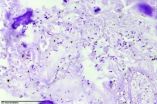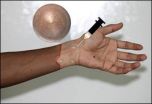(Press-News.org) Researchers from the Universities of York, Macquarie and Oxford have discovered new evidence to suggest that the origins of mummification started in ancient Egypt 1,500 years earlier than previously thought.
The scientific findings of an 11-year study by a researcher in the Department of Archaeology at York, and York's BioArCh facility, and an Egyptologist from the Department of Ancient History at Macquarie University, push back the origins of a central and vital facet of ancient Egyptian culture by over a millennium.
Traditional theories on ancient Egyptian mummification suggest that in prehistory -- the Late Neolithic and Predynastic periods between c. 4500 and 3100 B.C. -- bodies were desiccated naturally through the action of the hot, dry desert sand.
Scientific evidence for the early use of resins in artificial mummification has, until now, been limited to isolated occurrences during the late Old Kingdom (c. 2200 BC). Their use became more apparent during the Middle Kingdom (c. 2000-1600 BC).
But the York, Macquarie and Oxford team identified the presence of complex embalming agents in linen wrappings from bodies in securely provenanced tombs in one of the earliest recorded ancient Egyptian cemeteries at Mostagedda, in the region of Upper Egypt.
"For over a decade I have been intrigued by early and cryptic reports of the methods of wrapping bodies at the Neolithic cemeteries at Badari and Mostagedda," said Dr Jana Jones of Macquarie University, Sydney.
"In 2002, I examined samples of funerary textiles from these sites that had been sent to various museums in the United Kingdom through the 1930s from Egypt. Microscopic analysis with my colleague Mr Ron Oldfield revealed resins were likely to have been used, but I wasn't able to confirm my theories, or their full significance, without tapping into my York colleague's unique knowledge of ancient organic compounds."
Dr Jones initiated the research and led the study jointly with Dr Stephen Buckley, a Research Fellow at the University of York.
"Such controversial inferences challenge traditional beliefs on the beginnings of mummification," said Dr Jones. "They could only be proven conclusively through biochemical analysis, which Dr Buckley agreed to undertake after a number of aborted attempts by others. His knowledge includes many organic compounds present in an archaeological context, yet which are often not in the literature or mass spectra libraries."
Corresponding author on the article, Dr Buckley, used a combination of gas chromatography-mass spectrometry and sequential thermal desorption/pyrolysis to identify a pine resin, an aromatic plant extract, a plant gum/sugar, a natural petroleum source, and a plant oil/animal fat in the funerary wrappings.
Predating the earliest scientific evidence by more than a millennium, these embalming agents constitute complex, processed recipes of the same natural products, in similar proportions, as those employed at the zenith of Pharaonic mummification some 3,000 years later.
Dr Buckley, who designed the experimental research and conducted the chemical analyses, said: "The antibacterial properties of some of these ingredients and the localised soft-tissue preservation that they would have afforded lead us to conclude that these represent the very beginnings of experimentation that would evolve into the mummification practice of the Pharaonic period."
Dr Buckley added: "Having previously led research on embalming agents employed in mummification during Egypt's Pharaonic period it was notable that the relative abundances of the constituents are typical of those used in mummification throughout much of ancient Egypt's 3000 year Pharaonic history. Moreover, these resinous recipes applied to the prehistoric linen wrapped bodies contained antibacterial agents, used in the same proportions employed by the Egyptian embalmers when their skill was at its peak, some 2500-3000 years later."
Professor Thomas Higham, who was responsible for dating the burials at the University of Oxford, said: "This work demonstrates the huge potential of material in museum collections to allow researchers to unearth new information about the archaeological past. Using modern scientific tools our work has helped to illuminate a key aspect of the early history of ancient Egypt."
"Our ground-breaking results show just what can be achieved through interdisciplinary collaboration between the sciences and the humanities," said Dr Jones.
INFORMATION: END
Embalming study 'rewrites' key chapter in Egyptian history
2014-08-13
ELSE PRESS RELEASES FROM THIS DATE:
Injected bacteria shrink tumors in rats, dogs and humans
2014-08-13
A modified version of the Clostridium novyi (C. noyvi-NT) bacterium can produce a strong and precisely targeted anti-tumor response in rats, dogs and now humans, according to a new report from Johns Hopkins Kimmel Cancer Center researchers.
In its natural form, C. novyi is found in the soil and, in certain cases, can cause tissue-damaging infection in cattle, sheep and humans. The microbe thrives only in oxygen-poor environments, which makes it a targeted means of destroying oxygen-starved cells in tumors that are difficult to treat with chemotherapy and radiation. The ...
Treatment with lymph node cells controls dangerous sepsis in animal models
2014-08-13
An immune-regulating cell present in lymph nodes may be able to halt severe cases of sepsis, an out-of-control inflammatory response that can lead to organ failure and death. In the August 13 issue of Science Translational Medicine, a multi-institutional research team reports that treatment with fibroblastic reticular cells (FRCs) significantly improved survival in two mouse models of sepsis, even when delivered after the condition was well established. Even after treatment with antibiotics, sepsis remains a major cause of death.
"Our findings are important because, ...
Stimuli-responsive drug delivery system prevents transplant rejection
2014-08-13
Boston, MA – Following a tissue graft transplant—such as that of the face, hand, arm or leg—it is standard for doctors to immediately give transplant recipients immunosuppressant drugs to prevent their body's immune system from rejecting and attacking the new body part. However, there are toxicities associated with delivering these drugs systemically, as well as side effects since suppressing the immune system can make a patient vulnerable to infection.
A global collaboration including researchers from Brigham and Women's Hospital (BWH); Institute for Stem Cell Biology ...
Statistical model predicts performance of hybrid rice
2014-08-13
RIVERSIDE, Calif. — Genomic prediction, a new field of quantitative genetics, is a statistical approach to predicting the value of an economically important trait in a plant, such as yield or disease resistance. The method works if the trait is heritable, as many traits tend to be, and can be performed early in the life cycle of the plant, helping reduce costs.
Now a research team led by plant geneticists at the University of California, Riverside and Huazhong Agricultural University, China, has used the method to predict the performance of hybrid rice (for example, the ...
Story ideas from NCAR: Seasonal hurricane forecasts, El Niño, wind energy, and more
2014-08-13
BOULDER – Researchers at NCAR and partner organizations are making significant headway in predicting the behavior of the atmosphere on a variety of fronts, including:
improving weather forecasts
advancing renewable energy capabilities
helping satellites avoid space debris
estimating the risk of a crop slowdown due to climate change
These advances are summarized in short online features now published each week on our AtmosNews website: http://www.ucar.edu/atmosnews.
To get a jump on stories about new research, we invite you to sign up for our concise weekly ...
Single gene controls jet lag
2014-08-13
LA JOLLA–Scientists at the Salk Institute for Biological Studies have identified a gene that regulates sleep and wake rhythms.
The discovery of the role of this gene, called Lhx1, provides scientists with a potential therapeutic target to help night-shift workers or jet lagged travelers adjust to time differences more quickly. The results, published in eLife, can point to treatment strategies for sleep problems caused by a variety of disorders.
"It's possible that the severity of many dementias comes from sleep disturbances," says Satchidananda Panda, a Salk associate ...
NIH-led scientists boost potential of passive immunization against HIV
2014-08-13
WHAT:
Scientists are pursuing injections or intravenous infusions of broadly neutralizing HIV antibodies (bNAbs) as a strategy for preventing HIV infection. This technique, called passive immunization, has been shown to protect monkeys from a monkey form of HIV called simian human immunodeficiency virus, or SHIV. To make passive immunization a widely feasible HIV prevention option for people, scientists want to modify bNAbs such that a modest amount of them is needed only once every few months.
To that end, an NIH-led team of scientists has mutated the powerful anti-HIV ...
Foreshock series controls earthquake rupture
2014-08-13
A long lasting foreshock series controlled the rupture process of this year's great earthquake near Iquique in northern Chile. The earthquake was heralded by a three quarter year long foreshock series of ever increasing magnitudes culminating in a Mw 6.7 event two weeks before the mainshock. The mainshock (magnitude 8.1) finally broke on April 1st a central piece out of the most important seismic gap along the South American subduction zone. An international research team under leadership of the GFZ German Research Centre for Geosciences now revealed that the Iquique earthquake ...
Cell discovery brings blood disorder cure closer
2014-08-13
A cure for a range of blood disorders and immune diseases is in sight, according to scientists who have unravelled the mystery of stem cell generation.
The Australian study, led by researchers at the Australian Regenerative Medicine Institute (ARMI) at Monash University and the Garvan Institute of Medical Research, is published today in Nature. It identifies for the first time mechanisms in the body that trigger hematopoietic stem cell (HSC) production.
Found in the bone marrow and in umbilical cord blood, HSCs are critically important because they can replenish the ...
University of Tennessee research uncovers forces that hold gravity-defying near-earth asteroid together
2014-08-13
Researchers at the University of Tennessee, Knoxville, have made a novel discovery that may potentially protect the world from future collisions with asteroids.
The team studied near-Earth asteroid 1950 DA and discovered that the body, which rotates so quickly it defies gravity, is held together by cohesive forces called van der Waals, never detected before on an asteroid.
The findings, published in this week's edition of the science journal Nature, have potential implications for defending our planet from a massive asteroid impact.
Previous research has shown that ...




